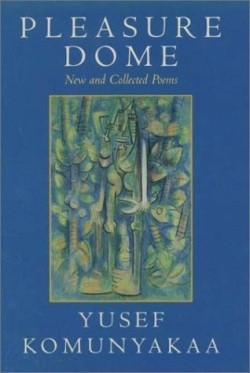Pleasure Dome
New and Collected Poems
A distinctive voice speaks throughout this generous offering of poems. A thousand people could cry out from the streets, but Komunyakaa’s voice would be the one heard. His voice is immediately recognizable due to its subjects and to an unusual colloquial style that uncovers dark and brooding underlying truths. These truths are best described by a startling metaphor at the closing of “Safe Subjects” as “black widow spiders / lay translucent eggs / in the skull of a dead mole / under a dogwood in full bloom.”
In a poem written to China Achebe, Komunyakaa refers to his work as “praisesongs / made of scar tissue.” Komunyakaa’s subjects are tragedies who either triumph over conditions in their lives or, especially in the war poems, do not triumph. Whether the shadowy figures carved out of the neon dark of jazz towns, sharecroppers, and hardscrabble workers from the segregated 1950’s of Bogaloosa, Louisiana, or the disfigured remains of the paddies and jungles of Nam, a touching humanity shines through these portraits of stark realism. In homages such as “Villon / Leadbelly” and “Elegy for Thelonius” life rises like a phoenix from the ashes. The reader sees this truth in the haunting image of Art Pepper’s blood on his saxophone reed.
Komunyakaa describes his own voice as “a wolf’s lost / in a cloud of migratory birds.” Yet this same voice can be movingly tender in its description of young revelers: “their small hands refuse to wound / the knowing scent hidden in each bloom.” This same voice in “Providence” can discover redemption in “a glimpse / nestled years later like a red bird / among wet leaves on a dull day.”
Meanwhile the reader will find in the section, Dien Cai Dau, one of the finest collections of poems from the Vietnam experience. Komunyakaa often juxtaposes the loveliness of the landscape with the appalling events of the war. For example, he ends “Starlight Scope Myopia” by peering down the sights of an M-16 to see “the full moon / loaded on an oxcart.” His description of a fallen comrade in “We Never Know”: “when I got to him, / a blue halo of flies had already claimed him” ranks with the best images of Dickey and Owen from earlier wars. He captures the distinctive difference of Nam from these earlier wars in “Tu Do Street”: “we fought / the brothers of these women / we now run to hold in our arms.”
Finally, it’s that small child in “The Smokehouse” who will linger in the reader’s mind the longest. It’s that child wearing Indian feathers and brass buttons from his mother’s coat who expresses the underlying truth of all Komunyakaa’s work—the heart is human and flawed, not humanless and flawless.
Reviewed by
Maurice Ferguson
Disclosure: This article is not an endorsement, but a review. The publisher of this book provided free copies of the book to have their book reviewed by a professional reviewer. No fee was paid by the publisher for this review. Foreword Reviews only recommends books that we love. Foreword Magazine, Inc. is disclosing this in accordance with the Federal Trade Commission’s 16 CFR, Part 255.

